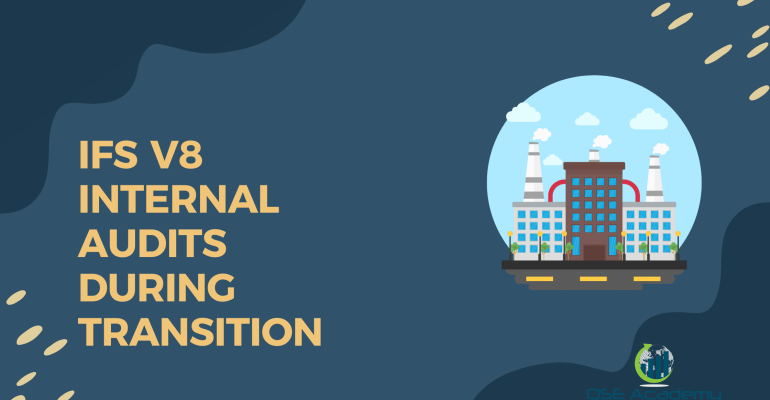IFS V8 Internal Audits During Transition
Last Updated on November 19, 2025 by Melissa Lazaro
Why Internal Audits Matter During the IFS V8 Transition
When a standard updates, most companies assume their existing internal audit process will still apply. But here’s what I’ve seen after guiding teams through multiple transitions: the companies that treat internal audits seriously during the shift phase usually walk into the certification audit with confidence — not uncertainty.
IFS V8 brings updated scoring expectations, clearer evidence requirements, and stronger focus on behavior and operational execution. So relying solely on IFS V7-style auditing can leave blind spots.
Internal audits during the transition aren’t just a compliance requirement — they’re your chance to catch gaps early, train teams, and test whether your system meets the new strength of expectation under V8.
Understanding the IFS V8 Audit Requirements and Scoring Updates
One of the key differences with V8 is the shift in how compliance is evaluated and scored. Some clauses were refined, KO expectations became clearer, and auditors are expected to judge consistency and behavior — not just whether a document exists.
That means internal audit tools must be updated to reflect:
- KO clauses and their expanded expectations
- Updated scoring logic
- What counts as sufficient evidence
- Stronger alignment with Codex and risk-based thinking
Here’s something I’ve noticed: when internal auditors don’t fully understand the scoring model, even strong systems end up with avoidable nonconformities.
So before running audits, train your internal auditors specifically on Version 8 scoring — not just the wording changes.
 Gap-Focused Internal Audit Planning: Prioritizing High-Impact Areas
Gap-Focused Internal Audit Planning: Prioritizing High-Impact Areas
During transition, internal audit planning shouldn’t be a copy-and-paste of last year’s program. It needs to be intentional.
A good starting point is prioritizing areas with:
- High regulatory impact
- Past audit findings
- KO relevance
- Significant operational risk
Typical high-priority topics include:
- Allergens
- HACCP validation
- Supplier controls
- Food safety culture evidence
- Traceability and recall testing
- Cleaning and sanitation verification
I’ve seen facilities make the mistake of starting with the easiest areas first — and then running out of time for the critical ones. When transitioning, reverse that approach: tackle the highest-risk areas first.
Updating Internal Audit Checklists, Forms, and Evidence Expectations
Your existing internal audit checklist likely doesn’t reflect IFS V8 expectations. Updating it is one of the most practical steps in the transition.
Your revised checklist should include:
- Clause reference
- Expected evidence
- Audit score aligned to V8 language
- Compliance status
- Corrective action field
- Responsible owner and deadlines
One mistake I see regularly is audits that only verify documentation. Under V8, checklists must guide auditors to review:
- Records
- Observations
- Interviews
- Process execution
If your checklist doesn’t drive the auditor to look beyond paper, you’ll miss gaps the external auditor won’t.
Conducting Process-Based Internal Audits: Observing Execution, Not Just Paperwork
IFS V8 places more weight on what’s happening in real operations — not what’s written in the manual.
A strong internal audit now includes:
- Watching how tasks are performed
- Interviewing operators at workstations
- Verifying records match operational reality
- Checking if controls happen consistently, not just occasionally
A good rule of thumb I share with teams:
“If staff can do the task but can’t explain why it matters, there’s a training or culture gap.”
And IFS V8 will call that out.
Internal Audit Reporting and Root-Cause-Driven Corrective Actions
Internal audits shouldn’t end with checkmarks — they should lead to meaningful improvements.
Your audit report should include:
- Clear nonconformity classification
- Impact level
- Root cause analysis (not just symptoms)
- Action plans
- Verification and closure evidence
IFS V8 expects corrective actions to solve the problem — not temporarily mask it.
A quick example:
If a form is filled incorrectly, the root cause isn’t “employee error.” It’s usually a missing training component, unclear instructions, or weak competence follow-up.
Mock Certification Audit: Practicing the IFS V8 Audit Style Before the Real One
A mock audit is one of the best tools during transition.
It should simulate:
- Audit structure
- Questions
- Scoring
- Evidence testing
- Behavior-based verification
- Realistic pressure
Mock audits help identify whether the system works not only on paper — but in daily practice.
The most successful facilities treat mock audits seriously. No shortcuts, no coaching answers, no “we’ll fix that later.”
Internal Audit Follow-Up and Transition Progress Review
After the audit, follow-up determines whether the transition succeeds.
Track:
- How many clauses have been fully verified
- How many corrective actions remain open
- Whether recurring patterns are emerging
- Whether improvements are measurable and sustainable
A simple dashboard works well here. It keeps leadership aligned, avoids surprises, and shows evidence of continuous improvement — something auditors appreciate under V8.
FAQs — IFS V8 Internal Audits During Transition
1. Do we need a full internal audit before transitioning to V8?
Yes — ideally once early in the transition and again closer to certification.
2. Can our existing internal auditors continue, or do they need new training?
They can continue, but training on V8 requirements and scoring is strongly recommended.
3. How soon before our official certification audit should we complete the final internal audit?
Most facilities aim for 6–12 weeks before the external audit, depending on gap severity.
Conclusion: Internal Audits Are Your Best Insurance During the IFS V8 Transition
Internal audits are one of the most powerful tools you have during this version change. They help you identify gaps early, build confidence, and make sure your system truly aligns with IFS V8 expectations — not just old habits.
Facilities that take internal auditing seriously during transition consistently achieve smoother audits and stronger certification outcomes.
If you’d like support, the next logical step is using an IFS V8-aligned internal audit checklist or running a mock audit review.
Melissa Lavaro is a seasoned ISO consultant and an enthusiastic advocate for quality management standards. With a rich experience in conducting audits and providing consultancy services, Melissa specializes in helping organizations implement and adapt to ISO standards. Her passion for quality management is evident in her hands-on approach and deep understanding of the regulatory frameworks. Melissa’s expertise and energetic commitment make her a sought-after consultant, dedicated to elevating organizational compliance and performance through practical, insightful guidance.








